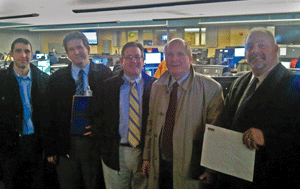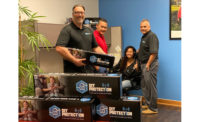
|
| American Alarm, ASG, Stanley and Wayne Alarm in the Boston Police Dept. 911 dispatch center. |
The Boston Police Department has adopted a new policy in its public safety answering point (PSAP) that gives dispatch priority to video intrusion alarms. A security industry group including representatives from Stanley CSS, ASG Security, American Alarm, Wayne Alarm Systems and Videofied has been campaigning for PSAPs to implement formal procedures to deal with alarm events where video that confirms a probable crime in progress is present. Boston is the first large city to formally implement such a policy.
The new procedure involves the use of two new codes in Boston’s computer aided dispatch (CAD) software to categorize these alarm events: VAC for video alarm commercial and VAR for video alarm residential. The procedure consists of the central station placing a call to the PSAP as it normally would and indicating that it is a video alarm. The appropriate VAC or VAR code is input by the operator along with the alarm information. The monitoring station sends the video clip of the alarm to a cityofboston.gov email address that forwards the email/clip to the police dispatcher workstations. The CAD transfers the alarm to one of six dispatchers (organized geographically) who are able to call up the video on their screens when they see the VAC or VAR code and dispatch the alarm as a priority to the officers in the field.
Boston’s CAD has the capability to specifically label a video alarm and give dispatchers the capability to view video clips and obtain additional information about a crime in progress. Traditional alarms have always received a priority 3 in the Boston CAD system and this has not changed. Now, however, video intrusion alarms receive a priority 1.
According to Jeff Kahn, general manager, Wayne Alarm Systems, “Since Video is another element in electronic detection, there potentially is a higher propensity for capture. Boston Police Department (BPD) had recently designed a state of the art 911 PSAP communications center and had future technologies in mind. They have always been early adopters of new technology.”
The BPD and its emergency communications division conducted a technical capability review and recommended priority be given to these alarms. The policy was then approved by the PSAP manager.
Keith Jentoft, president of Videofied, commented that the initiative is quickly spreading to Boston suburbs now that it’s been successfully deployed in the city.
Kahn added, “Video is one of many tools for alarm users. There are many legacy systems and customers who may not opt for this next generation integration. However, there are many instances in which it will help law enforcement and the customer.
“This is not some new mandate or threat to traditional alarms but a way that individual dealers can reach out to their local police departments and build a positive relationship beyond false alarm reduction — making arrests together.”
Jentoft also highlighted that priority for video alarms is not a threat to regular alarms or even a move to replace two-call verification. “It is still key to focus on normal alarm response. This policy is simply an HOV lane for video alarm. And HOV lanes aren’t anti-car… Alarm response still is what it always was,” Jentoft commented, adding that it is a mistake to replace two-call verification with video verification: “Early alarm ordinances like in Washington state that say you can have video instead of two-call verification actually weaken the concept. If you see somebody there you still want to make sure they’re not supposed to be there.” — By Sabrina Gasulla, Associate Editor





